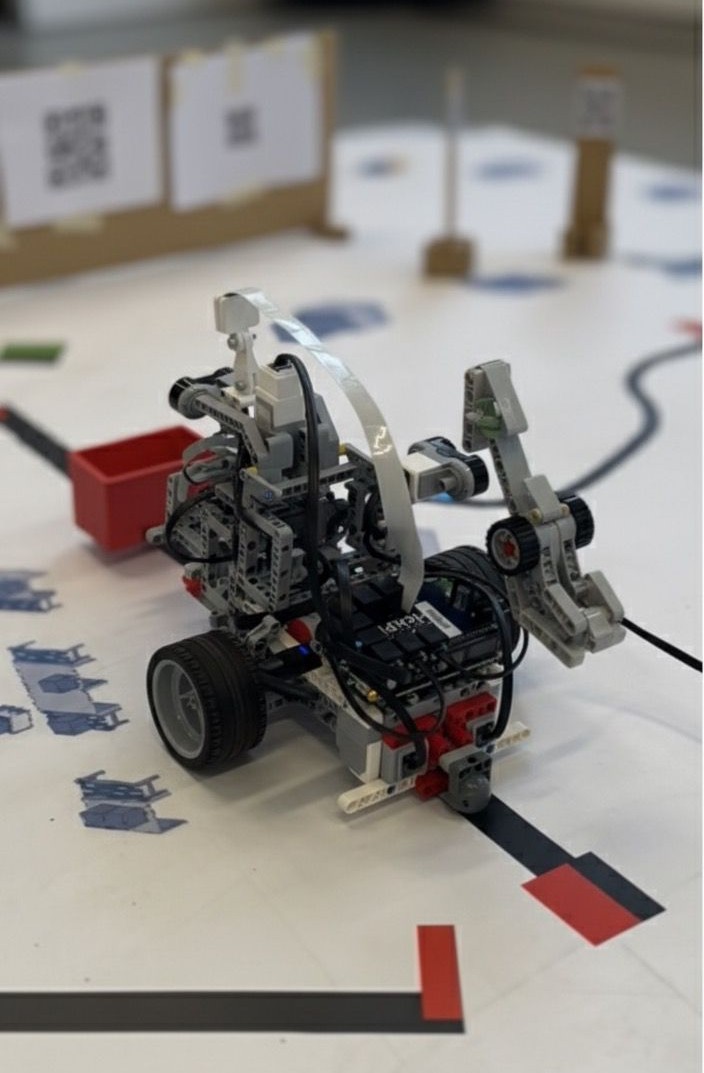Mobile Robotics Lab – Intralogistics Challenge
Autonomous mobile robot for intralogistics using Dijkstra path planning and OpenCV detection
🔹 Project Overview
This project was developed as part of the Mobile Robotics Laboratory Challenge, where teams simulated the automation of an entire intralogistics process using a mobile robot platform.
The goal was to demonstrate the feasibility of autonomous guided vehicles (AGVs) for internal material transport, similar to real-world operations at Meyer & Meyer Logistics.
Our robot was programmed to navigate autonomously through eight consecutive tasks involving lane following, path planning, obstacle avoidance, worker interaction, and packaging selection.

🔹 Hardware Platform
The mobile robot platform was developed using components provided by LFM at TUM.
It integrates modular sensors and actuators to simulate an industrial autonomous guided vehicle (AGV).
Main Hardware Components
- Controller Units
- Mindstorms EV3: Base control and motor interface
- BrickPi: Interface between EV3 components and Raspberry Pi
- Raspberry Pi: High-level computation for camera processing and MQTT communication
- Motors
- Locomotion: Independent control of the right and left wheels → Differential drive
- Load lifting: Servo-actuated lifting fork with parallel kinematics for container manipulation
- Sensors
- Color sensors (×2): Floor color detection for line following
- Distance sensors (×2): Measuring distances to the front and to the right for obstacle avoidance
- Color camera: Optical detection of the environment in front of the robot (used for QR/barcode reading and OpenCV-based object detection)
- Communication: MQTT via Wi-Fi module for worker-robot interaction
🔹 Scenario Description
The AGV operated on a miniature logistics testbed with black lane markings, colored task markers, QR codes, and barcodes.
The complete process chain consisted of:
- Start in Front of the Factory – Wait for a green traffic light before entering the area.
- Pick Up a Container at Goods Receipt – Identify the correct container via barcode comparison and pick it up.
- Storage Process – Use Dijkstra’s algorithm to plan the optimal route to one of the storage positions [g, i, k, l], deposit the container, and exit via [n].
- Interaction with Worker (MQTT) – Exchange task data with a virtual worker through MQTT, receiving packaging shape information for later use.
- Follow the Worker – Continuously follow a moving QR code representing the worker while maintaining safe distance.
- Bypass an Obstacle – Detect and classify obstacles using OpenCV-based object detection. If the obstacle remains for more than 10 seconds, execute a bypass maneuver maintaining a maximum 30 cm clearance.
- Packaging Identification – Match the received packaging shape with the correct station and place the container there.
- Return to Charging Station – Navigate back to the charging dock without lane guidance, relying on camera-based perception and obstacle monitoring.

🔹 System Architecture
The robot’s control software followed a modular, layered design:
- Challenge.py – Main control node managing the global state machine and task transitions
- Task Modules (task1–task8) – Independent state machines implementing each sub-task
- Perception Layer – OpenCV-based line tracking, QR and barcode decoding, and object detection
- Path Planning Layer – Dijkstra algorithm for shortest-path navigation
- Communication Layer – MQTT interface for simulated worker-robot collaboration
- Control Layer – PID-based motor control for stable trajectory tracking
🔹 Highlights
- Implemented Dijkstra path planning for warehouse navigation
- Developed OpenCV-based object detection for obstacle recognition and avoidance
- Built a modular, task-oriented framework covering all eight logistics processes
- Enabled MQTT communication for dynamic human–robot interaction
- Demonstrated fully autonomous end-to-end logistics operation
- 🏆 Achieved the maximum score among all groups in the challenge evaluation